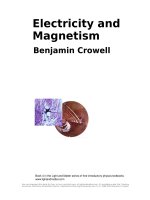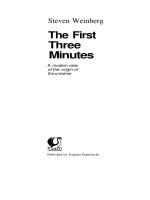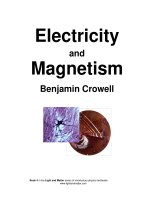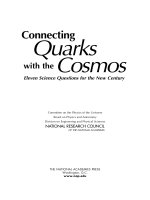- Trang chủ >>
- Khoa Học Tự Nhiên >>
- Vật lý
Waves principles of light electricity and magnetism secrets of the universe 6940
Bạn đang xem bản rút gọn của tài liệu. Xem và tải ngay bản đầy đủ của tài liệu tại đây (4.3 MB, 65 trang )
Secrets of the Universe
b y Pa u l F l e i s h e r
s
L e r n e r P u b l i c a t i o n s Co m p a n y • M i n n e a p o l i s
For Vanessa
Copyright © 2002 by Paul Fleisher
All rights reserved. International copyright secured. No part of this book may be
reproduced, stored in a retrieval system, or transmitted in any form or by any
means—electronic, mechanical, photocopying, recording, or otherwise—without
the prior written permission of Lerner Publications Company, except for the
inclusion of brief quotations in an acknowledged review.
The text for this book has been adapted from a single-volume work entitled
Secrets of the Universe: Discovering the Universal Laws of Science, by Paul Fleisher,
originally published by Atheneum in 1987. Illustrations by Tim Seeley were
commissioned by Lerner Publications Company. New back matter was
developed by Lerner Publications Company.
Lerner Publications Company
A division of Lerner Publishing Group
241 First Avenue North
Minneapolis, MN 55401 U.S.A.
Website address: www.lernerbooks.com
Library of Congress Cataloging-in-Publication Data
Fleisher, Paul.
Waves : principles of light, electricity, and magnetism / by Paul Fleisher
p. cm. — (Secrets of the universe)
Includes bibliographical references and index.
eISBN 0-8225-0708-0
1. Electromagnetic waves—Juvenile literature. [1. Light. 2. Electricity.
3. Magnetism.] I. Title. II. Series. Fleisher, Paul. Secrets of the Universe
QC661.F54 2002
539.2—dc21
00-012120
Manufactured in the United States of America
1 2 3 4 5 6 – JR – 07 06 05 04 03 02
Contents
Introduction: What Is a Natural Law? . . . . . . . .6
1. Optics
The Laws of Light . . . . . . . . . . . . . . . . . . .10
2. Laws of Electromagnetism . . . . . . . . . . . .25
3. Electric Current
Ohm’s Law and Joule’s Law . . . . . . . . . . .35
Inverse Square Laws . . . . . . . . . . . . . . . . . . . . . .44
Timeline . . . . . . . . . . . . . . . . . . . . . . . . . . . . . . . .48
Biographies of Scientists . . . . . . . . . . . . . . . . . . .50
For Further Reading . . . . . . . . . . . . . . . . . . . . . .58
Selected Bibliography . . . . . . . . . . . . . . . . . . . . .60
Glossary . . . . . . . . . . . . . . . . . . . . . . . . . . . . . . . .61
Index . . . . . . . . . . . . . . . . . . . . . . . . . . . . . . . . . . .62
About the Author . . . . . . . . . . . . . . . . . . . . . . . .64
I
NTRODUCTION
Everyone knows what a law is. It’s a
What Is
rule that tells people what they must or
must not do. Laws tell us that we
a Natural
shouldn’t drive faster than the legal
Law?
speed limit, that we must not take
someone else’s property, that we must
pay taxes on our income each year.
Where do these laws come from? In the United States
and other democratic countries, laws are created by elected
representatives. These men and women discuss which
ideas they think would be fair and useful. Then they vote to
decide which ones will actually become laws.
But there is another kind of law, a scientific law. For
example, you’ll read about Coulomb’s law later in this
book. Coulomb’s law tells us that the electrical force
between any two objects depends on two things: the
amount of electrical charge of each object, and the distance
between the objects. Where did Coulomb’s law come from,
and what could we do if we decided to change it?
7
What Is a Natural Law?
Coulomb’s law is very different from a speed limit or a
law that says you must pay your taxes. Speed limits are different in different places. On many interstate highways,
drivers can travel 105 kilometers (65 miles) per hour. On
crowded city streets, they must drive more slowly. But electrical force works exactly the same way no matter where
you are—in the country or the city, in France, Brazil, or the
United States.
Sometimes people break laws. When the speed limit is
89 kph (55 mph), people often drive 97 kph (60 mph) or
even faster. But what happens if you try to break
Coulomb’s law? You can’t. If you test one thousand electrically charged objects, you’ll find that each and every one
follows the rule described in Coulomb’s law. All objects
obey this law. And we know that the law stays in effect
whether people are watching or not.
Coulomb’s law is a natural law, or a rule of nature.
Scientists and philosophers have studied events in our
world for a long time. They have made careful observations
and done many experiments. And they have found that
certain events happen over and over again in a regular,
predictable way. You have probably noticed some of these
patterns in our world yourself.
A scientific law is a statement that explains how things
work in the universe. It describes the way things are, not
the way we want them to be. That means a scientific law
is not something that can be changed whenever we
choose. We can change the speed limit or the tax rate if we
think they’re too high or too low. But no matter how much
we might want electrical forces to work differently,
Coulomb’s law remains in effect. We cannot change it; we
can only describe what happens. A scientist’s job is to
describe the laws of nature as accurately and exactly as
possible.
The laws you will read about in this book are universal
laws. That means they are true not only here on Earth, but
Waves
8
elsewhere throughout the universe too. The universe
includes everything we know to exist: our planet, our solar
system, our galaxy, all the other billions of stars and galaxies, and all the vast empty space in between. All the evidence that scientists have gathered about the other planets
and stars in our universe tells us that the scientific laws that
apply here on Earth also apply everywhere else.
In the history of science, some laws have been found
through the brilliant discoveries of a single person. But
ordinarily, scientific laws are discovered through the efforts
of many scientists, each one building on what others have
done earlier. When one scientist—like Charles-Augustin
de Coulomb—receives credit for discovering a law, it’s
important to remember that many other people also contributed to that discovery. Almost every scientific discovery
is based on problems and questions studied by many earlier
scientists.
Scientific laws do change, on rare occasions. They don’t
change because we tell the universe to behave differently.
Scientific laws change only if we have new information or
more accurate observations. The law changes when scientists make new discoveries that show the old law doesn’t
describe the universe as well as it should. Whenever scientists agree to a change in the laws of nature, the new law
describes events more completely or more simply and
clearly.
A good example of this is the laws that describe electricity and magnetism. Scientists once thought that electricity
and magnetism were two separate and different things. But
new discoveries and improved measurements helped a
great scientist, James Clerk Maxwell, rewrite the laws that
describe how electricity and magnetism work. Maxwell
realized that electricity and magnetism are two different
forms of the same force. You will read about Maxwell’s discoveries later in this book.
Natural laws are often written in the language of
mathematics. This allows scientists to be more exact in their
descriptions of how things work. For example, Coulomb’s
law is actually written like this:
q(1) × q(2)
F = K × ––––––––––
d2
9
What Is a Natural Law?
Don’t let the math fool you. It’s the same law that
describes how electrical charges interact. Writing it this way
lets scientists accurately compute the actual electrical force
in many different situations here on Earth and elsewhere in
the universe.
The science of matter and energy and how they behave
is called physics. In the hundreds of years that physicists
have been studying our universe, they have discovered
many natural laws. In this book, you’ll read about several
of these great discoveries. There will be some simple experiments you can do to see the laws in action. Read on and
share the fascinating stories of the laws that reveal the
secrets of our universe.
C
HAPTER
When we look into the sky at
1
Optics—The
night, we see the light from
thousands of different stars. We
Laws of Light
see the Moon and the planets,
shining with reflected sunlight.
The whole universe sparkles
with light. But what is light, and
what natural laws describe its behavior?
The branch of physics that studies light is called optics.
Some of the world’s greatest scientists, including Newton,
Huygens, Maxwell, and Einstein, have studied optics, trying to understand the laws of light.
One law that describes the behavior of light has been
known for two thousand years. The Greek philosophers
didn’t know what light was, but they did know that it travels in straight lines. The law of reflection depends on this fact.
When light bounces off a mirror or other surface, this is
known as reflection. When you see yourself in a mirror, you
are seeing light that has reflected from your face to the mirror
and then back to your eyes. The law of reflection says: The
angle of incidence is equal to the angle of reflection.
The angle of incidence is the angle of the light shining
onto the reflector. The angle of reflection is the angle of the
light bouncing off the reflector. The law of reflection says
that those two angles are always equal. If a light shines on
a mirror at a 45-degree angle, it will bounce off the mirror
at that same angle. The same is true no matter at what angle
the light is shining.
You can easily see the effects of this law by using a small
mirror, a flashlight, some cardboard and tape, and a little bit
of chalk dust or flour. Draw a straight line down the center
of a square piece of cardboard. Then fold the cardboard in
half along this line. On a second piece of cardboard, trace
11
Optics
You can see the path of light reflections by shaking fine powder
into the air.
Waves
12
around the lens end of your flashlight. Cut along your
traced line, then poke a small hole in the center of the cutout shape. Cover the lens of the flashlight with it, taping it
securely in place. That will give you a narrow beam of light
when you turn on the flashlight.
Place the mirror on a table. Stand the folded piece of
cardboard on the table, centered behind the mirror. This
will give you a vertical line to use to compare the angles of
the light beam. Shake a very small amount of the chalk dust
or flour into the air, to make the beam of the flashlight visible. Darken the room and shine the light onto the center of
the mirror.
Notice that the beam of light bounces off the mirror at
the same angle that it hits the mirror. It doesn’t matter at
what angle you hold the flashlight beam. The angle of the
light reflected from the mirror will always match it exactly.
Light travels in straight lines. But light also bends when
it travels from one kind of transparent material to another.
If you stick a pencil into a glass of water, the pencil will
appear to bend where it enters the water.
Of course, the pencil doesn’t actually bend. It looks bent
because the light traveling through the water bends. This
bending of light is called refraction. Notice that the pencil
seems to bend only at the surface of the water, where the
water and air meet. Refraction takes place only at the
boundary between two transparent materials.
Each transparent substance bends light at certain predictable angles. Refraction occurs because light travels at
different speeds in different substances. The amount of
refraction depends on the difference in the speed of light in
the two transparent materials. The bigger the difference in
the speed of light between the two materials, the more the
light will bend as it passes between them.
Light travels faster in air than it does in water. When
light moves from air to water, it slows down. And as it does,
it also refracts, or bends. Light travels even more slowly in
glass. When light moves from air to glass, it bends even
more. A pencil placed partly behind a thick piece of glass
would seem to bend even more than the pencil in water.
One scientist who studied optics was Isaac Newton.
Newton knew that when sunlight is refracted in a glass
prism, the white light breaks up into a rainbow of colors,
called a spectrum. Newton proved that sunlight is actually
composed of all the colors of the rainbow.
Many years later, the astronomer William Herschel discovered the existence of another kind of light—light that
can’t be seen. In 1800 Herschel was measuring the temperature of the different colors in the spectrum. He wanted to
find out whether red, orange, yellow, green, or blue light
produced the most heat. He used a glass prism to break
sunlight into a spectrum. Then he measured each of the colors with a thermometer.
13
Optics
A surprising rise in temperature led Herschel to discover the
existence of invisible infrared light.
100
kilometers
(60 miles)
AM radio
1
kilometer
(0.6 miles)
FM radio
Waves
Radio
waves
14
TV
1
meter
(40 inches)
Microwaves
Radar
0.001
meter
(0.04 inch)
Infrared
0.000001
meter
(0.00004 inch)
VISIBLE LIGHT
Ultraviolet
0.00000001
meter
(0.0000004 inch)
0.0000000000001
meter
(0.000000000004
inch)
Gamma
rays
X rays
The electromagnetic spectrum includes an extremely wide range
of light waves.
15
Optics
Herschel found that the hottest part of the spectrum
was alongside the red part, in a place where he couldn’t see
any light at all! But the thermometer proved that some
invisible light rays were there. Herschel had discovered the
existence of infrared light.
One year later, light on the other side of the visible spectrum was found. This light couldn’t be seen either, but it
did form images on photographic plates. This light became
known as ultraviolet light. In the mid-1800s, James Clerk
Maxwell showed that the spectrum of light includes much
more than just the light we can see. We now know that the
entire spectrum includes not just visible light, but also radio
waves, infrared light, ultraviolet light, X rays, and gamma
rays.
Newton’s studies of light in the late 1600s and early
1700s started one of the longest debates in the history of science. The debate, which wasn’t settled for more than two
hundred years, was over the question of whether light is a
shower of tiny particles or a series of waves.
To understand the question, you need to know something about the behavior of waves. Waves can be seen most
easily in a wave tank. To make a wave tank at home, you’ll
need a clear glass baking dish, a sheet of white paper, and a
bright desk lamp. You will also need two pencils and several small blocks of wood to make obstacles for the waves.
Fill the baking dish about two-thirds full of water. Place
it on a table, on top of the sheet of paper. Place the lamp so
that it shines down on the water from directly above. Now
tap the water in the pan with the eraser end of a pencil to
create some waves. You’ll see that the waves create shadows on the paper below, making them easier to see.
Remember that the waves you are seeing are water waves,
but other waves, including light, have similar properties.
Place a small wooden block in the pan as an obstacle. On
one side of the block, make some waves with your pencil.
Watch what happens when the waves go past the obstacle.
Waves
16
In a wave tank, waves diffract, or curve, around an object placed
in their path.
Notice that the waves curve around the obstacle and
travel into the part of the tank that is blocked off. This curving of waves around an obstacle is called diffraction.
Diffraction is a characteristic of all waves.
To scientists in the 1600s, light didn’t seem to diffract
the way other waves do. Light seems to travel in straight
lines, instead of curving around obstacles. If you place an
object in sunlight, it casts a shadow. If light diffracted as
water waves do, you would expect the light to bend around
the object and make a fuzzy shadow. But light casts a shadow with sharp edges.
Because of this, Newton believed that light must be
made of many tiny, swift particles moving in straight paths.
When an object interrupts the particles, sharp-edged shadows are the result.
After Newton suggested that light is made of particles,
two other noted scientists disagreed. Robert Hooke and
17
Optics
If light were made of particles, you would expect sharp shadows
(top). If light were made of waves, you would expect the shadow
to be less distinct (bottom).
Christiaan Huygens pointed out that light also behaves like
waves. Let’s use the wave tank again to show their side of
the argument.
Waves
Block off one section in your wave tank, leaving only a
small central opening to the rest of the tank. With your pencil, make some waves in the blocked section of the tank.
Notice what happens when they pass through the opening.
The waves coming through the opening spread out just
the way they spread out from the source of the waves itself.
Huygens noted that any point along a wave can act as if it
is a new source of more waves. The waves from this new
source will have the same characteristics as the original
waves. This rule is known as Huygens’ principle.
That’s exactly what happens when you allow light to
shine through a small hole. It spreads out from the opening,
just as if that opening were the source of the light.
Huygens also pointed out that if light were made of
waves, that would explain its property of refraction. Light
waves moving through different materials would travel at
18
In a wave tank, waves passing through a small opening spread
out just as if the opening were the actual source of the waves.
different speeds. The change of speed would cause the
waves to bend. It was harder to explain why “particles” of
light should bend as they pass into water or glass.
Waves have another interesting behavior that is called
interference. To see interference in your wave tank, you will
need to make waves with two pencils. Hold the pencils a
couple of inches apart. Then tap the surface of the water
with both of them at the same time, in a regular pattern, creating two sets of waves.
Notice that as the two sets of waves overlap and cross,
they interact with each other. In some places they cancel
each other out, and in other places they add to each other’s
effects. This is called interference. If you keep up a steady
19
Optics
Light passing through a small opening behaves as if the opening
itself were the light source.
Waves
20
Two wave sources produce a pattern of interference.
pattern of waves with regular movements of your pencils,
you should get a steady pattern of interference.
It’s a characteristic of waves that they produce interference patterns as they cross each other. When streams of particles cross, we would expect them to collide. No one has
observed collisions when two beams of light shine across
each other. But does light produce interference?
In 1801 the English physicist Thomas Young proved
that light does diffract and does produce interference
patterns, just as other waves do. It seemed that the
light/particle question was finally resolved.
You can easily see an interference pattern of light using
two pencils and your desk lamp. Hold the two pencils in
front of your eye as you look toward the lamp. Move the
pencils closer together, until they are almost touching. You
will see a pattern of very fine light and dark lines. That is
frequency = 5 waves per second
1 second
wavelength
Waves can be measured by their wavelength or by their frequency.
21
Optics
the interference pattern produced as light from the lamp
passes through the narrow slit between the two pencils. The
dark lines are the places where the waves of light are
canceling each other out. Since light produces interference
patterns as other waves do, it too must be a wave.
Young also calculated the actual size of light waves. The
wavelengths of light waves are very small, but Young managed to measure them. Different colors of light turned out
to have different wavelengths. Young found that the wavelength of red light is about 76 millionths of a centimeter (30
millionths of an inch). The wavelength of blue light is even
smaller, about 38 millionths of a centimeter (15 millionths of
an inch).
Young’s measurements explained why the diffraction of
light is so hard to see. Diffraction occurs when waves bend
around an obstacle. But light waves are so tiny that they can
bend only around tiny obstacles—obstacles not much bigger than the size of atoms.
By the mid-1800s, it seemed certain that light was made
of waves. But even then the question wasn’t settled. Around
1900 new discoveries by Max Planck and Albert Einstein
brought back the particle theory. The end result turned out
to be that both sides of the debate were right! Light usually
behaves like a wave, but it acts like a particle too.
Waves
22
Is there a law that describes the brightness of light? Yes.
The faint stars that we see in the night sky are actually blazing suns. Their light is much dimmer after its long journey
to our planet. The farther you get from a light source, the
less bright the light appears. In fact, the intensity of light
from any source decreases very rapidly as the distance from
the source increases. The decrease is proportional to the
square of the distance. Squaring the distance means multiplying the distance times itself.
This special relationship between brightness and the
distance from the light source is called an inverse square
relationship. Many other forces in nature weaken with distance in similar ways. A more detailed explanation of why
this is so begins on page 44. In the meantime, just think how
much light our Sun must produce. It is extremely bright,
even though we are about 150 million kilometers (93 million miles) away!
We need to consider one more fact about light—its
speed. Galileo Galilei was the first scientist to try measuring the speed of light. He stood on a hill with a covered
lantern and placed an assistant on a distant hill with a second lantern. He uncovered his lantern. As soon as his assistant saw the light, he was supposed to uncover his lantern.
Galileo planned to measure the time it took for him to
receive the signal back again.
Unfortunately, the experiment didn’t work. The light
seemed to travel between the two hilltops almost instantaneously. Light moves so fast that measuring its speed is
very difficult.
The first successful attempt to measure the speed of
light used Earth’s orbit as a measuring stick. The Danish
astronomer Olaus Rømer knew when eclipses of Jupiter’s
moons were scheduled to occur in the late 1600s. He
noticed that the timing of the eclipses varied, depending on
where Jupiter and Earth were in their orbits. If the two
planets were on opposite sides of the Sun, the eclipses were
a few minutes late. If the two planets were on the same side
of the Sun, the eclipses were a few minutes early.
Rømer realized that the time difference was caused by
the difference in distance that the light from Jupiter’s moon
had to travel before it was seen on Earth. Rømer knew the
approximate diameter of Earth’s orbit. He knew how much
extra distance the light had to travel to cross that orbit. So
he could estimate how fast the light traveled to cross that
distance. Rømer calculated that light travels at about
226,000 kilometers (140,000 miles) per second.
In 1849 the French physicist Armand Fizeau was the
first scientist to create a device to measure the speed of light
in a laboratory experiment. Since that time, many other
researchers have made more and more exact measurements
of the speed of light. The most famous of them was the
23
Jupiter
(July)
Mercury
Earth
(July)
Jupiter
(January)
Venus
Earth
(January)
Rømer used different positions of Earth’s orbit to measure the
speed of sunlight reflected from Jupiter.
Optics
Mars
Waves
24
American physicist Albert Michelson. He devoted most of
his life to accurately determining the speed of light.
Michelson won the Nobel Prize in 1907, in honor of the
many ingenious experiments he used to measure the speed
of light as precisely as possible.
Scientists now put the speed of light at 299,792.5 kilometers per second, or 186,281.7 miles per second. Those
speeds are usually rounded off to 300,000 kilometers per
second, or 186,000 miles per second. This is a very important
measurement. The speed of light can be considered the
“speed limit” of the universe. As far as we know, it is impossible for anything to travel faster than the speed of light.
The speed of light is 300,000 kilometers per second in a
vacuum (totally empty space). Light travels almost as fast
in air. In other materials, such as water or glass, the speed
of light is much slower. For example, light travels about
225,000 kilometers per second (140,000 miles per second) in
water and about 200,000 kilometers per second (124,000
miles per second) in glass. It is this difference in speed that
causes light to refract, or bend, when it moves between one
substance and another.
Light is such a familiar part of our everyday world that
it’s easy to forget how special and important it is. We can
see our world only because it is bathed in a constant stream
of light, which reflects off of the objects around us and into
our eyes. The universe is full of light traveling at enormous
speeds from distant stars and galaxies. It is this light that
lets us know what’s “out there” beyond our own world.
Light is our most important connection to everything in the
universe that lies beyond our own planet. Without an
understanding of light, science could never understand the
rest of the universe at all.









